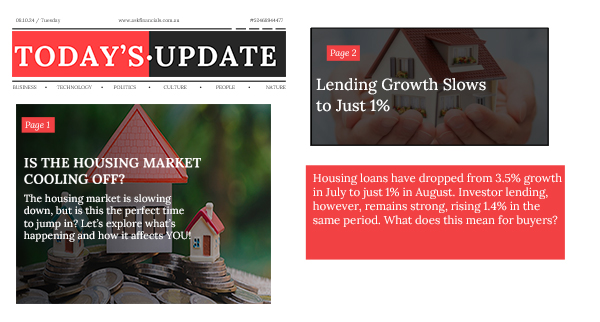Today’s highlight:
| Housing Market Trends in Australia
• Housing lending slows to 1% month-on-month in August, a drop from the 3.5% rise in July. • Investor lending rose 1.4% month-on-month in August, up 34.2% over the past year. • Queensland led the nation in lending growth, with a significant 41% year-on-year increase. • Building approvals fell by 6.1% in August, reversing the strong 11% rise in July. • Private unit approvals decreased by 16.5%, but private house approvals showed a modest increase. • Capital city housing prices showed signs of cooling, growing just 0.5% month-on-month in September. • Regional variation in housing price trends is highlighted, with Perth experiencing the strongest price growth. • Housing prices are forecast to rise by 7.3% in 2024, slowing to 5.5% in 2025. |
Recent August data has seen the housing market slowdown, and most of its indicators have begun to shift the momentum. According to ANZ, the pace of housing lending, excluding refinancing, has slowed down to just 1% month on month, which comes from a 3.5% increase in July. The cooling pattern breathes into the much-needed questions regarding sustainability in the housing market and what it implies for buyers and investors.
Investor Lending Remains Resilient
While the overall lending has slowed, there is still a brighter history in regards to investor lending. Investor lending grew 1.4% month over month in August and accounted for a healthy year-over-year advance of 34.2%. This resilience might indicate persistent investors’ interest to enter the market-a protracted push by so-far favourable conditions or long-term strategy.
Queensland has emerged as the star performer in terms of lending growth, with a year-on-year increase of 41%. Such statistics highlight, in particular, how investor lending has surged to the extent of 58.5%. This puts forward the indicator that investors have an appetite for the state, and this expresses confidence in investing in Queensland.
Western Australia was not far behind with a stellar 58.1% rise in investor lending over that period. Of course, this trend would thus indicate region-specific variations within a housing market-some regions booming while others dragging along.
Building Approvals Drop by 4.8%; Suggest Wider Easing of Demand
Another indicator of a cooling housing market is a fall in building approvals. In August, building approvals fell 6.1%, which reversed the strong 11% rise seen in July. A more general easing of demand in the market seems to be driving the fall as developers and would-be homeowners weigh up their plans against changing economic circumstances.
The drop was largely caused by a 16.5% fall in the approvals of private units. This could be said to be an indication of change in consumer preference where people will opt for standalone homes compared to apartments. However, private house approvals had a soft uptrend, 0.5% month-on-month and 5.9% on a year-to-date basis. This reveals that although the market is cooling, it still appears to have steady demand for new houses.
However, it is observed that unit approvals, which presented the foundation of the market’s weakness, are now 2.2% lower compared to the comparative period during the year-to-date. The worrying signal here is the viability of new unit development, especially in urban areas where supply has allegedly outpaced demand.
Housing Prices in Capital City Reflect Cooling Trend
The ripples of these trends can be seen in the capital city housing prices that have also begun to cool off. In September, the capital city housing prices rose merely by 0.5% month over month. Average growth Q3 has eased to 0.4% from the 0.6% value registered during Q2. It can be seen here that the rapid price increases experienced over previous months might be levelling off since the market is proving to internalise new economic realities.
Remarkably, however, Perth and Adelaide are notable exceptions at a national level, with both reporting price rises in excess of 1%. It is also remarkable to see how Perth has become one of the good performers, rising 18% year-to-date. Such figures can be symptomatic of growing demand in these markets, which may well be fueled by some underlying local economic or population conditions, or even other factors.
At the same time, Melbourne, Hobart, and Canberra are experiencing a downward trend of prices. For example, Melbourne sales volume has outstripped listings. There is a feeling of rising demand not balanced by adequate supply that must result in dipping prices.
Diverse Trends in Housing Prices Across Regions
Regional differences in the housing price trends have also emerged more clearly. Dunk says that “Outcomes vary significantly across regions, with some regions doing well while others are lagging behind.” For instance, Perth is likely to end the year with a 25% increase in the housing prices, Adelaide with a rise of about 15%, and Brisbane about the same.
Such disparities point to the importance of paying attention to local market dynamics in investment decisions. For investors considering entry into the housing market, attractive regions would be those that have appeared to exhibit strong growth trends, like Perth and Adelaide, but careful entry into a falling market would have to be taken.
By contrast, Melbourne and Hobart markets are weak and are likely to continue downward. The Melbourne situation is alarming because a sales volume mismatched with new listings pushed it down. The trend would ring an alarm, if it persisted-it may imply a long stagnation period for Melbourne.
Outlook for the Housing Market
There is some cautious optimism going forward in the housing market’s near-term outlook. Prospects show house prices rising 7.3 percent this year, but growth is anticipated to decelerate to 5.5 percent in 2025. Such deceleration would mean that, even though the market may still be rising, the breakneck growth pace experienced at its peak in earlier years is coming to a close.
It should be noted here that regional disparities would continue playing a strong role in determining the housing scenario in different parts of the country. Perth and Adelaide are likely to witness higher growth rates as compared to Melbourne and Hobart. This variance in performance calls for the attention of those potential buyers and investors who are required to comprehend the overall local conditions and trends.
As the market cools, the playing field may be at its advantage to the buyers. Less competition and stabilised prices could prove the right entry point for the first-time homebuyer into the market. For the investor, the key will be identifying areas with strong fundamentals and growth potential with sensitivity to areas in decline.
Is now the right time to buy? Let’s talk strategy
With the housing market hitting a pause, having a reliable partner to navigate these shifting circumstances is crucial. As lending trends decelerate and regional differences become more pronounced, a distinctive opportunity emerges for astute buyers and investors. Timing is everything—and that’s precisely where ASK Financials steps in.
At ASK Financials, our seasoned mortgage brokers are ready to guide you through this cooling market with assurance. Whether you’re stepping into homeownership for the first time or an investor on the hunt for high-growth opportunities in places like Queensland or Perth, we’re here to craft a personalised strategy that aligns with your unique needs and aspirations. We’ll evaluate your borrowing potential and secure the most competitive rates, guaranteeing your success regardless of market fluctuations.
Seize this chance before it’s gone! Reach out to ASK Financials now for professional insights, and mortgage solutions that transform the current market into your opportunity. Seize the moment—it’s time to turn your property aspirations into achievements!
To learn more on the recent updates Book A Discovery Call Today!!


